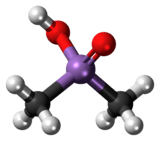Cacodylic acid
Cacodylic acid is the organoarsenic compound with the formula (CH3)2AsO2H. With the formula R2As(O)OH, it is the simplest of the organoarsinic acids. It is a colorless solid that is soluble in water.
 | |
 | |
| Names | |
|---|---|
| IUPAC name
Dimethylarsinic acid | |
| Other names
Dimethylarsenic acid, Cacodylic acid, Hydroxydimethylarsine oxide, Arsecodile, Ansar, Silvisar, Phytar 560, DMAA, UN 1572 | |
| Identifiers | |
3D model (JSmol) |
|
| 1736965 | |
| ChEBI | |
| ChEMBL | |
| ChemSpider | |
| DrugBank | |
| ECHA InfoCard | 100.000.804 |
| EC Number |
|
| 130562 | |
| KEGG | |
PubChem CID |
|
| RTECS number |
|
| UNII | |
| UN number | 1572 |
CompTox Dashboard (EPA) |
|
| |
| |
| Properties | |
| C2H7AsO2 | |
| Molar mass | 137.9977 g/mol |
| Appearance | White crystals or powder |
| Odor | odorless |
| Density | > 1.1 g/cm3 |
| Melting point | 192 to 198 °C (378 to 388 °F; 465 to 471 K) |
| Boiling point | > 200 °C (392 °F; 473 K) |
| 66.7 g/100 ml | |
| Solubility | soluble in ethanol, acetic acid insoluble in diethyl ether |
| Acidity (pKa) | 6 |
| -79.9·10−6 cm3/mol | |
| Structure | |
| triclinic | |
| Hazards | |
| Safety data sheet | External MSDS |
| GHS pictograms |   |
| GHS Signal word | Danger |
GHS hazard statements |
H301, H331, H400, H410 |
| P261, P264, P270, P271, P273, P301+310, P304+340, P311, P321, P330, P391, P403+233, P405, P501 | |
| NFPA 704 (fire diamond) | |
| Lethal dose or concentration (LD, LC): | |
LD50 (median dose) |
700 mg/kg (rat, oral) |
Except where otherwise noted, data are given for materials in their standard state (at 25 °C [77 °F], 100 kPa). | |
| Infobox references | |
Neutralization of cacodylic acid with base gives cacodylate salts, e.g. sodium cacodylate. They are potent herbicides. Cacodylic acid/sodium cacodylate is a buffering agent in the preparation and fixation of biological samples for electron microscopy.
History
In the 18th century it was found that combining As2O3 and four equivalents of potassium acetate (CH3CO2K) gives a product called "Cadet's fuming liquid" which contains cacodyl oxide, ((CH3)2As)2O and cacodyl, ((CH3)2As)2.
Early research into "cacodyls" was reported by Robert Bunsen at the University of Marburg. Bunsen said of the compounds, "the smell of this body produces instantaneous tingling of the hands and feet, and even giddiness and insensibility...It is remarkable that when one is exposed to the smell of these compounds the tongue becomes covered with a black coating, even when no further evil effects are noticeable". His work in this field led to an increased understanding of the methyl group.
Cacodyl oxide, ((CH3)2As)2O, is often considered the first organometallic compound to be prepared synthetically.
Cacodylic acid and its salts were incorporated into herbicides by large variety of manufacturers under numerous brand names. APC Holdings Corp. sold cacodylic acid and its salts under the Phytar brand name.[1] The variety used in Vietnam (as Agent Blue) was Phytar 560G.[2] "Agent Blue," a mixture of cacodylic acid and sodium cacodylate was used during the Vietnam War as a defoliant.
Reactions
Cacodylic acid is a weak acid with a pKa of 6.[3]
Cacodylic acid can be reduced to dimethylarsine , which is a versatile intermediate for the synthesis of other organoarsenic compounds:[4][5]
- (CH3)2AsO2H + 2 Zn + 4 HCl → (CH3)2AsH + 2 ZnCl2 + 2 H2O
- (CH3)2AsO2H + SO2 + HI → (CH3)2AsI + SO3 + H2O
Health effects
Cacodylic acid is highly toxic by ingestion, inhalation, or skin contact. The U.S. EPA states that all forms of arsenic are a serious risk to human health and the United States' Agency for Toxic Substances and Disease Registry ranked arsenic as number 1 in its 2001 Priority List of Hazardous Substances at Superfund sites.[6] Arsenic is classified as a Group-A carcinogen.[6]
See also
References
- Stanley A. Greene (2005). Sittig's Handbook of Pesticides and Agricultural Chemicals. William Andrew. p. 132. ISBN 978-0-8155-1903-4.
- Committee to Review the Health Effects in Vietnam Veterans of Exposure to Herbicides; Institute of Medicine (1994). Veterans and Agent Orange: Health Effects of Herbicides Used in Vietnam. National Academies Press. pp. 89–90. ISBN 978-0-309-55619-4.
- Henry B.F.Dixon (1996). "The Biochemical Action of Arsonic Acids Especially As Phosphate Analogues". Advances in Inorganic Chemistry. Advances in Inorganic Chemistry. 44. pp. 191–227. doi:10.1016/S0898-8838(08)60131-2. ISBN 9780120236442.
- Feltham, R. D.; Kasenally, A.; Nyholm, R. S. (1967). "A New Synthesis of Di- and Tri-Tertiary Arsines". Journal of Organometallic Chemistry. 7 (2): 285–288. doi:10.1016/S0022-328X(00)91079-9.CS1 maint: uses authors parameter (link)
- Burrows, G. J. and Turner, E. E., "A New Type of Compound containing Arsenic", Journal of the Chemical Society Transactions, 1920, 1374-1383
- Dibyendu, Sarkar; Datta, Rupali (2007). "Biogeochemistry of Arsenic in Contaminated Soils of Superfund Sites". EPA. United States Environmental Protection Agency. Retrieved 25 February 2018.
- Kenyon, E. M.; Hughes, M. F. (2001). "A Concise Review of the Toxicity and Carcinogenicity of Dimethylarsenic Acid". Toxicology. 160 (1–3): 227–236. doi:10.1016/S0300-483X(00)00458-3. PMID 11246143.
- Elschenbroich, C; Salzer, A. (1992) Organometallics, 2nd Edition
- Bunsen Biography
